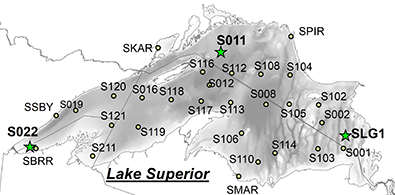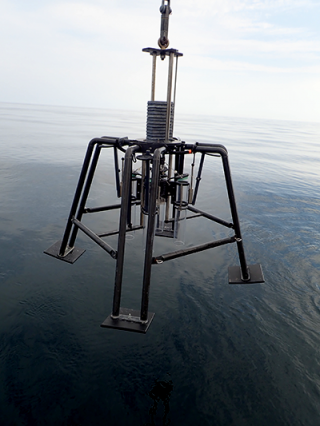2021 Surveys Conducted on Lake Guardian
In 2021, the R/V Lake Guardian supported four Lake Superior CSMI surveys. This page presents summaries of the science and participating partners:
On this page:
Lower Food Web Contaminants Survey

Contaminants in the aquatic ecosystem can bioaccumulate through the food chain and potentially become present at higher concentrations in predator fish at the top of the food chain, such as lake trout and walleye.
U.S. Environmental Protection Agency’s Great Lakes National Program Office has monitored contaminant levels in top predator fish in the Great Lakes through the Great Lakes Fish Monitoring and Surveillance Program since the late 1970s. EPA collects fish from fixed sampling sites in each lake and then analyzes them for contaminants and reports the results.
- Great Lakes Fish Monitoring and Surveillance
- Great Lakes Fish Monitoring and Surveillance 2016 Technical Report (published 2021)
To better understand contaminant cycling in the Great Lakes open water food web, EPA and EPA-funded researchers from Clarkson University, SUNY-Fredonia, SUNY-Oswego, and Academic Environmental/ Analytical Consulting Services, LLC will assess the concentrations of legacy contaminants and chemicals of emerging concern in the lower food web as part of the 2021 Lake Superior Cooperative Science and Monitoring Initiative and in support of the GLFMSP.
- Great Lakes Cooperative Science and Monitoring Initiative
- EPA Awards $16 million in Great Lakes Restoration Initiative Grants to Central Michigan and Clarkson Universities (April 2021 EPA news release)
Sampling will be conducted from the EPA research vessel Lake Guardian at the Apostle Islands and Keweenaw Point long-term GLFMSP fish collection sites. Researchers will collect water, phytoplankton, zooplankton and benthic organisms for contaminant analyses, thus targeting the major components of the Lake Superior lower food web.
Results from the Lake Superior CSMI GLFMSP surveys supplement EPA’s long-term datasets. This survey and the GLFMSP are supported by the Great Lakes Restoration Initiative.
Lake Superior Great Lakes Sediment Surveillance Program Survey

In September 2021, scientists from University of Minnesota Duluth (Natural Resources Research Institute, Large Lakes Observatory), U.S. Geological Survey Mercury Research Laboratory, EPA and Oak Ridge Institute for Science and Education completed EPA’s Great Lakes Sediment Surveillance Program (GLSSP) survey in Lake Superior. Using the Research Vessel Lake Guardian as a sampling platform, scientists collected surface sediment and sediment cores to characterize the spatial and temporal distribution of persistent bioaccumulative and/or toxic chemicals in the Great Lakes. Some key chemicals being analyzed include polychlorinated biphenyls (PCBs), polybrominated diphenyl ethers (PBDEs), per- and poly- perfluoroalkyl substances (PFAS), and mercury. Scientists collected surface sediment at 31 sampling stations, including five nearshore river mouth stations. The spatial and temporal distribution of legacy and emerging chemicals will be compared between modern and historic sediment. The scientists will also investigate how natural organic matter composition and microbial metabolic processes influence the sedimentation and re-mobilization of sediment contaminants.
EPA’s GLSSP, supported by the Great Lakes Restoration Initiative (GLRI), was established in 2010 to monitor the spatial distribution and temporal trends of persistent, bioaccumulative, and/or toxic chemicals in sediments of the Great Lakes. Data collected by the scientists gives important insight into how quickly chemical concentrations change in response to management actions. The data also can identify new chemicals of emerging concern. The GLSSP currently monitors more than 250 contaminants in sediment at 157 sites within the Great Lakes. These sites focus primarily on the offshore waters of the Great Lakes, but also include several nearshore sites near major river inflows to the lakes. EPA will continue sediment monitoring in each of the Great Lakes over the next 4 years. Sediment monitoring in each Great Lake in support of the GLSSP will continue over the next 4 years.


